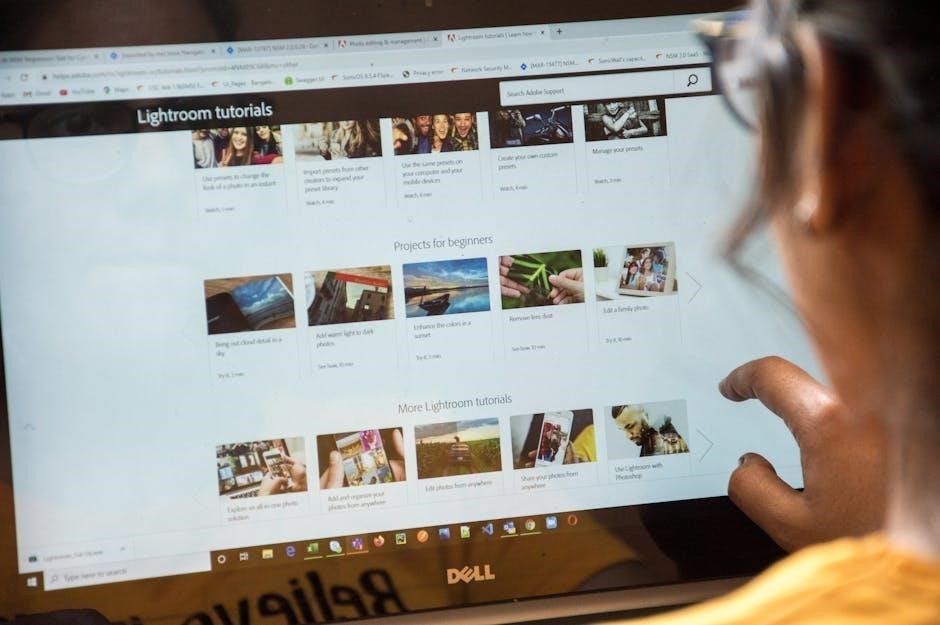Navigating the internet effectively is essential in today’s digital world․ The NYT crossword clue, “Guide to navigating an internet resource,” highlights the importance of mastering online tools․ John Green’s curriculum, developed with MediaWise, emphasizes critical thinking and digital literacy, providing structured learning for users of all levels․ Understanding how to navigate websites, use search engines, and evaluate information is crucial for a seamless online experience․ This guide offers insights and strategies to enhance your internet navigation skills, ensuring you make the most of digital resources․
1․1 Understanding the Basics of Internet Navigation
Mastering the fundamentals of internet navigation involves understanding URLs, search engines, and hyperlinks․ A URL is a web address used to locate specific resources, while search engines like Google help users find information․ Hyperlinks enable easy navigation between pages․ Additionally, John Green’s curriculum emphasizes critical thinking and digital literacy, teaching users to evaluate online sources effectively․ These basics form the foundation for seamless internet exploration and resource discovery․
1․2 Importance of Effective Navigation in Digital Spaces
Effective navigation in digital spaces enhances user experience, reduces frustration, and boosts productivity․ It allows users to quickly locate information, access resources, and complete tasks efficiently․ With the vast amount of online content, clear navigation is key to avoiding overwhelm․ Tools like search engines, browser extensions, and well-designed websites simplify this process․ John Green’s curriculum and partnerships with MediaWise emphasize these skills, ensuring users can thrive in the digital landscape․ Mastering navigation is essential for making the most of internet resources․

Guide to Solving the NYT Crossword Puzzle Clue
The NYT crossword clue “Guide to navigating an internet resource” appeared on March 11, 2024, with a 7-letter answer․ John Green’s curriculum offers related tips․
2․1 Deciphering the Clue: “Guide to Navigating an Internet Resource”
The crossword clue “Guide to navigating an internet resource” appeared in the New York Times on March 11, 2024․ The solution, a 7-letter word, was highlighted as Guide, emphasizing its role in navigating digital spaces․ This clue aligns with John Green’s curriculum on internet literacy, which focuses on critical thinking and evaluating online information․ The answer underscores the importance of effective navigation tools and resources in today’s digital landscape․
2․2 Historical Context and Previous Solutions
The crossword clue “Guide to navigating an internet resource” first appeared in the NYT on March 11, 2024․ It was part of a series focused on digital literacy, aligning with John Green’s curriculum on internet navigation․ Previous solutions highlighted the importance of critical thinking and online evaluation skills․ The clue has since become a key reference in discussions about effective internet navigation, inspiring educational programs and public discussions on the topic․

Essential Internet Navigation Tips
Mastering search engines, utilizing browser tools, and effectively navigating websites are key to a seamless online experience․ These skills enhance productivity and efficiency in digital spaces daily․
3․1 Mastering Search Engines for Better Results
Mastering search engines is crucial for efficient internet navigation․ Using specific keywords, refining searches, and understanding advanced search techniques can yield better results․ Tools like Google’s SEO guide offer insights into optimizing searches․ John Green’s curriculum, in partnership with MediaWise, emphasizes critical thinking for evaluating online sources․ Leveraging browser extensions and understanding how search algorithms work can further enhance your search efficiency, making it easier to find reliable information quickly and effectively online․
3․2 Utilizing Browser Tools and Extensions
Browser tools and extensions can significantly enhance your internet navigation experience․ Ad blockers help reduce clutter, while password managers ensure secure access to accounts․ Extensions like grammar checkers and dark mode toggles improve productivity․ Additionally, tools like browser bookmarks and tab organizers help streamline your workflow․ By leveraging these features, you can customize your browsing experience, making it more efficient and tailored to your needs․ This ensures a smoother and more enjoyable time online․
3․3 Navigating Websites Effectively
Navigating websites effectively involves using site maps, search bars, and menus to quickly find information․ Understanding a site’s structure helps identify primary sections like home, about, and contact pages․ Using browser tools like bookmarks and tab management can enhance your experience․ Additionally, evaluating the credibility of sources and avoiding distractions ensures a more productive browsing session․ These strategies help users efficiently locate and utilize online resources․

Understanding the Role of UX in Internet Resources
User experience (UX) design plays a crucial role in creating intuitive internet resources․ It focuses on seamless navigation and efficient information retrieval, enhancing overall user satisfaction․
4․1 Design Principles for Seamless Navigation
Effective UX design relies on clear layouts, intuitive controls, and consistent navigation․ Principles like visibility, accessibility, and feedback ensure users can easily find what they seek․ Clear labeling and logical information hierarchy reduce cognitive load, while responsive design adapts to different devices․ Accessibility features, such as alt text for images and keyboard navigation, ensure inclusivity․ These principles, inspired by experts like Jakob Nielsen, create user-friendly experiences that enhance navigation and satisfaction․
4․2 The Impact of User Experience on Information Retrieval
A seamless user experience directly enhances information retrieval by reducing barriers to accessing content․ Poorly designed interfaces can lead to frustration, misnavigation, and incomplete searches․ Intuitive design, clear information hierarchy, and accessibility features ensure users can efficiently locate and evaluate information․ This aligns with the guide’s emphasis on critical thinking and digital literacy, enabling users to navigate resources effectively and retrieve accurate, relevant data, as highlighted by MediaWise and John Green’s curriculum․

Critical Thinking for Internet Users
Critical thinking is vital for evaluating online information․ John Green’s curriculum, developed with MediaWise, teaches users to assess sources and avoid misinformation, fostering informed navigation and decision-making skills․
5․1 Evaluating Online Information Sources
Evaluating online sources is crucial for accuracy․ John Green’s curriculum, developed with MediaWise, teaches users to assess credibility, identify biases, and verify information through cross-referencing․ Understanding domain credibility, author expertise, and publication dates helps distinguish reliable sources․ Avoiding misinformation requires proactive critical thinking and media literacy skills, essential for navigating the vast digital landscape effectively․
5․2 Avoiding Misinformation and Fake News
Avoiding misinformation requires a proactive approach․ John Green’s curriculum with MediaWise and The Poynter Institute emphasizes critical thinking to identify fake news․ Users should verify sources, check for corroboration, and be cautious of sensational headlines․ Understanding the intent behind content helps recognize biases or deceit․ By fostering media literacy, individuals can navigate online information more effectively and make informed decisions․

The Role of Education in Internet Literacy
Education plays a vital role in fostering internet literacy․ John Green’s curriculum, developed with MediaWise, teaches critical thinking and digital literacy, empowering users to navigate online resources effectively․
6․1 John Green’s Curriculum for Internet Navigation
John Green’s curriculum, created in partnership with MediaWise, focuses on teaching users to evaluate online information critically; Through engaging lessons, students learn to navigate the internet effectively, identify credible sources, and avoid misinformation․ This hands-on approach equips learners with essential skills to discern reliable content and use digital tools responsibly, fostering a generation of informed and discerning internet users․
6․2 Partnerships with MediaWise and The Poynter Institute
Collaborations with MediaWise and The Poynter Institute enhance internet navigation education․ These partnerships provide evidence-based resources and expert knowledge, ensuring users receive accurate guidance․ Their combined efforts focus on promoting digital literacy and critical thinking, empowering individuals to navigate online spaces confidently and responsibly․

Technical Aspects of Internet Navigation
Understanding technical elements like URLs, IP addresses, and internet service providers is crucial․ Devices connect via Wi-Fi or cellular data, enabling access to online resources efficiently․
7․1 Understanding URLs and IP Addresses
A URL (Uniform Resource Locator) is a web address used to locate resources on the internet․ IP addresses are unique numbers assigned to devices, enabling data transfer․ Understanding how URLs and IP addresses work is fundamental for effective navigation․ URLs help users access specific websites, while IP addresses ensure devices communicate properly․ DNS (Domain Name System) translates URLs into IP addresses, making browsing seamless․ This technical backbone ensures efficient internet navigation and resource access․
7․2 The Importance of Internet Service Providers
Internet Service Providers (ISPs) play a crucial role in connecting users to the internet․ They provide the infrastructure and services necessary for accessing online resources․ ISPs manage data transmission, ensuring reliable and efficient connectivity․ Without ISPs, users cannot access websites, emails, or other digital services․ They also offer varying speeds and security features, making them indispensable for navigating the internet effectively and securely․ Choosing the right ISP is vital for a smooth online experience․
SEO and Its Impact on Navigation
SEO significantly influences how users discover and interact with online content․ By optimizing visibility and accessibility, SEO enhances navigation, making it easier for users to find relevant information efficiently․
8․1 How Search Engine Optimization Affects User Experience
SEO plays a crucial role in shaping user experience by improving the visibility and relevance of online content․ Optimized websites rank higher in search results, making it easier for users to find what they need․ This reduces bounce rates and enhances satisfaction․ Additionally, SEO encourages better site design and content structure, indirectly improving navigation and accessibility․ By aligning with user intent, SEO ensures a more seamless and intuitive online experience․
8․2 Google’s Role in Shaping Internet Navigation
Google has revolutionized internet navigation by providing intuitive search engines and tools․ Its algorithms prioritize relevance, ensuring users find accurate information quickly․ Features like Google Maps and Chrome enhance navigation, while Google’s dominance influences how websites optimize content․ The company’s innovations, such as voice search and AI-driven results, continue to shape how users interact with the internet, making it more accessible and user-friendly for everyone navigating digital spaces․

Navigating the New York Times Website
The NYT website offers a user-friendly interface with a search bar, sections for news, opinion, and multimedia․ Customization options allow personalized reading experiences, enhancing navigation and engagement for users seeking quality content and interactive features like crossword puzzles and in-depth articles․
9․1 Key Features of the NYT Website
The NYT website features a clean, intuitive design with a prominent search bar, section navigation, and personalized recommendations․ Users can access breaking news, archives, multimedia content, and interactive features like crossword puzzles․ The site also offers customizable notifications, a “Saved” section for favorites, and a mobile-responsive layout ensuring seamless access across devices․ These features enhance user experience, making it a comprehensive resource for news and information․
9․2 Customizing Your NYT Experience
Customizing your NYT experience allows for a tailored approach to news consumption․ Users can adjust notification settings, save articles for later, and personalize their homepage layout․ The website also offers display options, such as font size and night mode, enhancing readability․ Additionally, readers can follow specific topics or journalists, ensuring a personalized feed․ These customization tools empower users to create a unique and efficient browsing experience suited to their preferences and needs․

Staying Updated with Internet Trends
Staying updated with internet trends is crucial for effective navigation․ Follow tech news, SEO guides, and educational resources like John Green’s curriculum to stay informed and adapt․
10․1 The Evolution of Internet Navigation Tools
Internet navigation tools have evolved significantly, from basic URL typing to advanced search engines․ Tools like Google offer features such as autocomplete and filters, enhancing user experience․ The development of browser extensions and educational resources, such as John Green’s curriculum with MediaWise, has further simplified navigation․ These advancements ensure users can efficiently find and evaluate information, adapting to the ever-changing digital landscape with ease and precision․
10․2 Adapting to New Technologies in Digital Spaces
Adapting to new technologies in digital spaces is crucial for effective internet navigation․ Emerging tools like AI-driven search engines and browser extensions streamline user experiences․ The integration of lateral reading, as taught in John Green’s curriculum, helps users evaluate information efficiently․ Staying informed about updates and leveraging educational partnerships ensures users remain adept at navigating the ever-evolving digital world, making the most of new technologies to enhance their online skills and knowledge․

Avoiding Common Pitfalls in Internet Navigation
Effective internet navigation requires avoiding pitfalls like misinformation and insecure browsing․ Critical thinking, as emphasized in John Green’s curriculum, helps users discern reliable sources․ Employing secure practices and staying vigilant against fake news ensures a safer online experience, aiding users in navigating digital spaces with confidence and accuracy․
11․1 Recognizing and Overcoming Navigation Challenges
Navigating the internet can present challenges like misinformation and complex website structures․ To overcome these, users should employ strategies such as bookmarking reliable sources and using search engines effectively․ Leveraging browser tools like extensions can enhance efficiency․ Additionally, staying focused on specific goals and avoiding distractions helps in navigating digital spaces more seamlessly․ By adopting these practices, users can mitigate common obstacles and improve their overall online experience․
11․2 Best Practices for Secure Browsing
Secure browsing is crucial for protecting personal data․ Always use HTTPS websites and avoid suspicious links․ Keep your browser and antivirus software updated․ Use strong, unique passwords and enable two-factor authentication․ Regularly clear browsing data and avoid using public Wi-Fi for sensitive transactions․ By following these practices, you can significantly reduce the risk of cyber threats and ensure a safer online experience․
The Future of Internet Navigation
The future of internet navigation is evolving rapidly, with AI and voice search leading the charge․ Augmented reality and smarter algorithms will redefine how we explore online, making experiences more intuitive and personalized than ever before․
12․1 Emerging Trends in Digital Navigation
Emerging trends in digital navigation are reshaping how we interact online․ AI-powered tools enhance search results, while voice search and augmented reality create immersive experiences․ Privacy-focused technologies like VPNs and ad blockers are gaining traction․ Meanwhile, 5G networks promise faster, more seamless browsing․ These advancements aim to make navigation more intuitive, accessible, and user-centric, ensuring a dynamic future for internet exploration and information retrieval․
12․2 The Role of AI in Shaping Future Navigation
AI is revolutionizing internet navigation by personalizing experiences․ Intelligent algorithms learn user preferences, offering tailored search results and recommendations․ AI-driven tools like chatbots enhance accessibility, assisting users in real-time․ Additionally, AI improves content curation, ensuring relevance while combating misinformation․ As AI evolves, it promises to streamline navigation, making the internet more intuitive and user-friendly․ These advancements are critical for adapting to the ever-changing digital landscape․
13․1 Summarizing Key Takeaways
13․2 Encouraging Continuous Learning and Adaptation
Continuous learning and adaptation are vital for mastering internet navigation․ As digital tools evolve, staying informed about new technologies and strategies ensures effective use of online resources․ John Green’s curriculum, in partnership with MediaWise and others, offers a foundation for lifelong learning․ Encourage regular practice, exploration of new tools, and engagement with educational content to remain proficient in navigating the ever-changing digital landscape․
